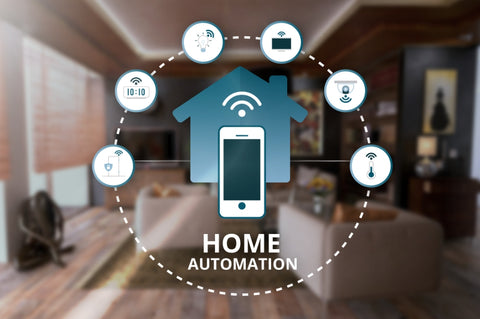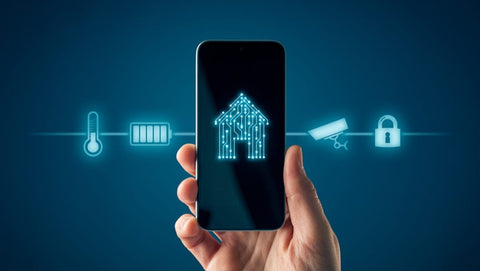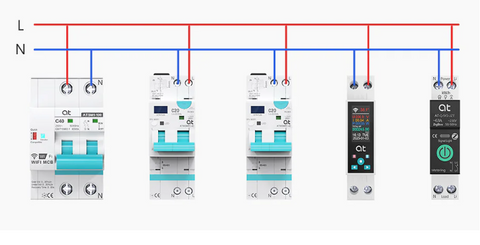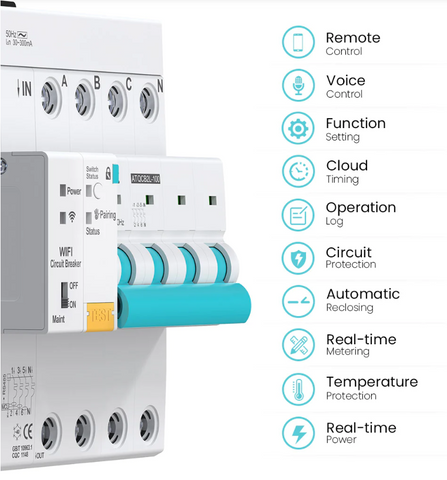How WiFi Breaker Detect and Prevent Electrical Hazards

Electrical safety is paramount to preventing accidents, ensuring the longevity of electrical systems, and safeguarding lives. As technology advances, innovative solutions emerge to enhance electrical safety measures.
Introducing WiFi circuit breakers—advanced devices that not only stop electrical currents but also identify and stop possible dangers. In this blog, we explore how WiFi Breakers – these silent guardians are revolutionizing electrical safety.
I. Understanding Electrical Hazards
A. Common Electrical Hazards
1. Overloading: The excessive demand on an electrical system, exceeding its capacity.
2. Short Circuits: A direct connection between two points in an electrical circuit.
3. Ground Faults: When an unintended path provides a low-resistance connection to the ground.
B. Consequences of Electrical Hazards
The repercussions of electrical hazards extend beyond immediate dangers. Fires, equipment damage, and disruptions to daily life are among the potential consequences.
C. Traditional Methods of Addressing Electrical Hazards
Historically, circuit breakers have been the frontline defense against electrical hazards. While effective, traditional breakers have limitations that WiFi breakers aim to overcome.
II. The Evolution of Circuit Breakers
A. Historical Perspective on Circuit Breakers
Tracing back to their inception, circuit breakers have played a crucial role in electrical safety. However, as technology evolves, so do the challenges they face.
B. Limitations of Traditional Circuit Breakers
While traditional circuit breakers have been reliable, they often lack the ability to proactively identify and address emerging electrical issues.
C. Introduction of WiFi Breaker
Introducing the WiFi Breaker, an electrical equipment with advanced technology and live monitoring to improve electrical safety. In the next sections, we'll delve into the inner workings of these intelligent safeguards.
Coming up next in our series: "How WiFi Breakers Work." Discover the features that make them the protectors of electrical systems.
III. How WiFi Breaker Work
A. Overview of Smart Breaker Technology
In the realm of electrical safety, WiFi breakers represent a paradigm shift. Unlike their traditional counterparts, these cutting-edge devices go beyond the simple task of interrupting electrical currents. They leverage advanced technologies to actively monitor, detect, and prevent potential hazards.
B. Real-Time Monitoring and Detection Capabilities
1. Current Sensing
WiFi Breaker employ sophisticated current sensors that continuously monitor the flow of electricity. This real-time data allows them to identify irregularities, such as sudden spikes or fluctuations, indicative of potential issues.
2. Voltage Monitoring
Voltage monitoring is a key feature that enables WiFi Breaker to detect variations in electrical voltage. Voltage changes can indicate issues with appliances or wiring, so the smart breaker takes action to prevent problems.
3. Advanced Analytics
The integration of advanced analytics is a game-changer. WiFi Breaker analyze the collected data using algorithms, identifying patterns and anomalies that might go unnoticed with traditional systems. This predictive capability allows for proactive hazard mitigation.
C. Communication Protocols and Connectivity
WiFi Breaker are not isolated entities; they are part of a connected ecosystem. Using Wi-Fi, Bluetooth, or Zigbee, these devices communicate with control systems or directly with users. This connectivity ensures a swift response to emerging issues and allows for remote management.
IV. Features and Benefits of WiFi Breaker
A. Remote Monitoring and Control
One of the standout features of WiFi Breaker is the ability to be monitored and controlled remotely. Users can use apps to view real-time data on their electrical systems. This allows them to have peace of mind and the ability to respond quickly. It doesn't matter if they are far from the property.
B. Predictive Maintenance
WiFi Breaker not only responds to immediate threats but also forecasts potential issues. By analyzing usage patterns and system data, they can predict when components might require maintenance or replacement. This proactive approach minimizes downtime and reduces the risk of sudden failures.
C. Customizable Settings for Different Environments
Every environment has its unique electrical characteristics and challenges. WiFi Breaker lets users customize settings for best performance in different settings, like homes or industrial facilities.
D. Integration with Smart Home Systems
In the era of smart homes, integration is key. WiFi Breaker seamlessly integrates with other smart home devices and systems. This interconnectedness enhances overall home automation, creating a cohesive and intelligent ecosystem where devices work in harmony to maximize efficiency and safety.
V. Case Studies: WiFi Breaker in Action
A. Real-World Examples of WiFi Breaker in Action
Let's explore real-life examples where WiFi circuit breakers have shown their worth in the electrifying world of technology.
1. WiFi Breaker Prevent Fire Catastrophe:
In a residential setting, a smart breaker detected an abnormal heat pattern caused by a faulty appliance. Before the situation escalated, the smart breaker swiftly cut power to the affected circuit, preventing a potential fire. This real-time response showcased the life-saving capabilities of these silent guardians.
2. Industrial Efficiency Boost:
In an industrial facility, WiFi circuit Breaker were integrated into the electrical infrastructure. Through continuous monitoring and predictive maintenance alerts, downtime because of unexpected breakdowns was significantly reduced. The WiFi Breaker not only ensured safety but also optimized the overall efficiency of the operation.
B. Success Stories and Positive Outcomes
1. Enhanced Safety Measures:
Property owners and managers have reported an increased sense of security with the implementation of WiFi Breaker. Monitoring electrical systems remotely and receiving instant notifications empowers users to take proactive measures, preventing potential hazards before they escalate.
2. Cost Savings Through Predictive Maintenance:
Businesses that have adopted WiFi Breaker have reported substantial cost savings. The predictive maintenance features help them solve problems before they become serious, saving money on emergency repairs and equipment replacements.
C. Comparison with Incidents Involving Traditional Breakers
1. Swift Response vs. Delayed Action:
Traditional breakers rely on manual intervention or basic tripping mechanisms, which may result in delayed responses to emerging electrical issues. WiFi Breaker, with their real-time monitoring and automated responses, showcase a marked improvement in addressing incidents promptly.
2. Proactive Prevention vs. Reactive Measures:
The proactive nature of WiFi circuit breakers distinguishes them from their traditional counterparts. Rather than simply reacting to overloads or short circuits, WiFi Breaker anticipate potential hazards by analyzing data, enabling a preventative approach to electrical safety.
VI. Challenges and Considerations

A. Potential Limitations of WiFi Breaker
While WiFi Breaker herald a new era in electrical safety, it's essential to acknowledge potential limitations. Possible issues with older systems, strong connectivity needed, and learning curve when adopting advanced technologies.
B. Cybersecurity Concerns
As WiFi Breaker become integral to connected systems, cybersecurity emerges as a critical consideration. Keeping communication protocols secure and preventing unauthorized access is crucial to protect the electrical infrastructure from cyber threats.
C. Cost Considerations and ROI Analysis
The upfront costs of implementing smart breaker technology may pose a challenge for some. A detailed ROI analysis reveals long-term benefits. These benefits include lower maintenance costs, less downtime, and improved safety. These benefits justify the initial investment.
VII. The Future of Electrical Safety
A. Advancements in Smart Breaker Technology
The future promises continuous innovation in smart breaker technology. Anticipate better sensing, smarter algorithms, and improved integration with other smart devices and systems for more accurate predictions.
B. Potential Integration with Renewable Energy Systems
WiFi Breaker will be important in combining renewable energy systems as the world moves towards sustainable energy sources. Being able to adjust to changing renewable sources and ensuring smooth energy distribution will be a main focus.
C. Impact on Overall Electrical Infrastructure and Safety Standards
The widespread adoption of WiFi Breaker has the potential to reshape safety standards and regulations in the electrical industry. As these technologies become more common, regulations may adapt to include and standardize the use of WiFi Breakers in various settings.
VIII.Conclusion
Electrical safety is a fundamental aspect of our daily lives, impacting both individuals and industries. As technology evolves, so must our approach to mitigating electrical hazards. WiFi Breaker is a silent guardian for electrical systems, with real-time monitoring, predictive abilities, and automated responses. They not only address current challenges but also pave the way for a safer and more efficient future.
Despite challenges, WiFi Breaker has many benefits: preventing hazards, reducing costs, and contributing to a sustainable future. These reasons make it worth encouraging its adoption. As we navigate the future of electrical safety, let us embrace the silent guardians that WiFi Breaker represent.
Contact:
sale@at-ele.com





